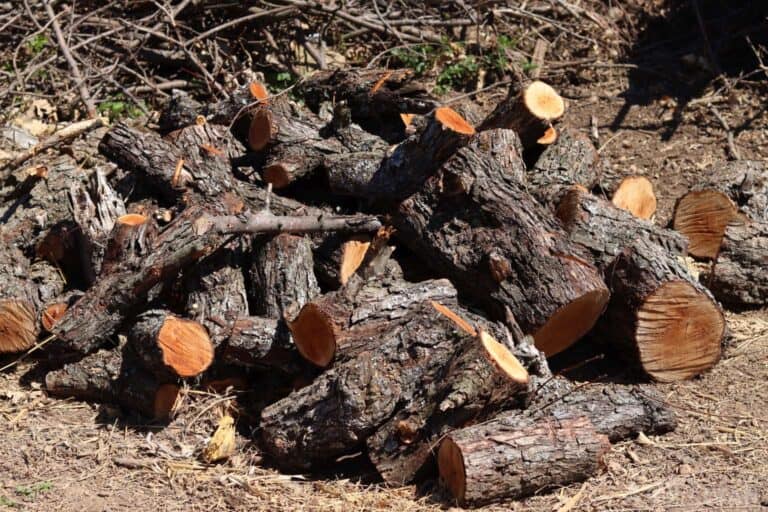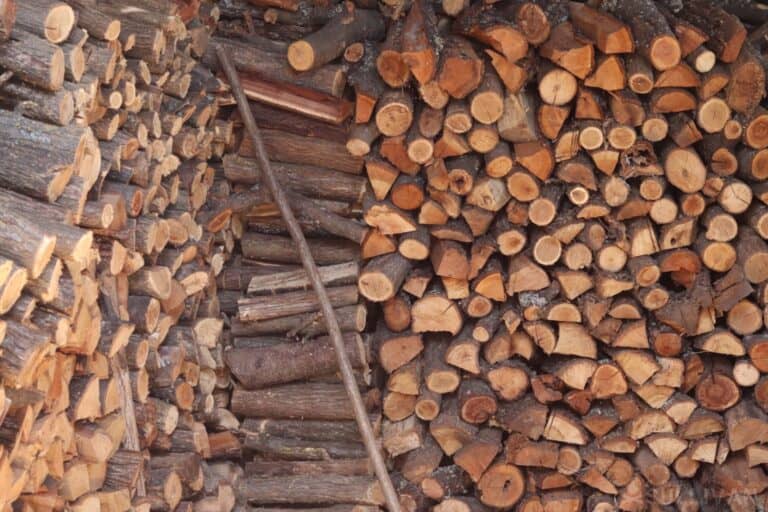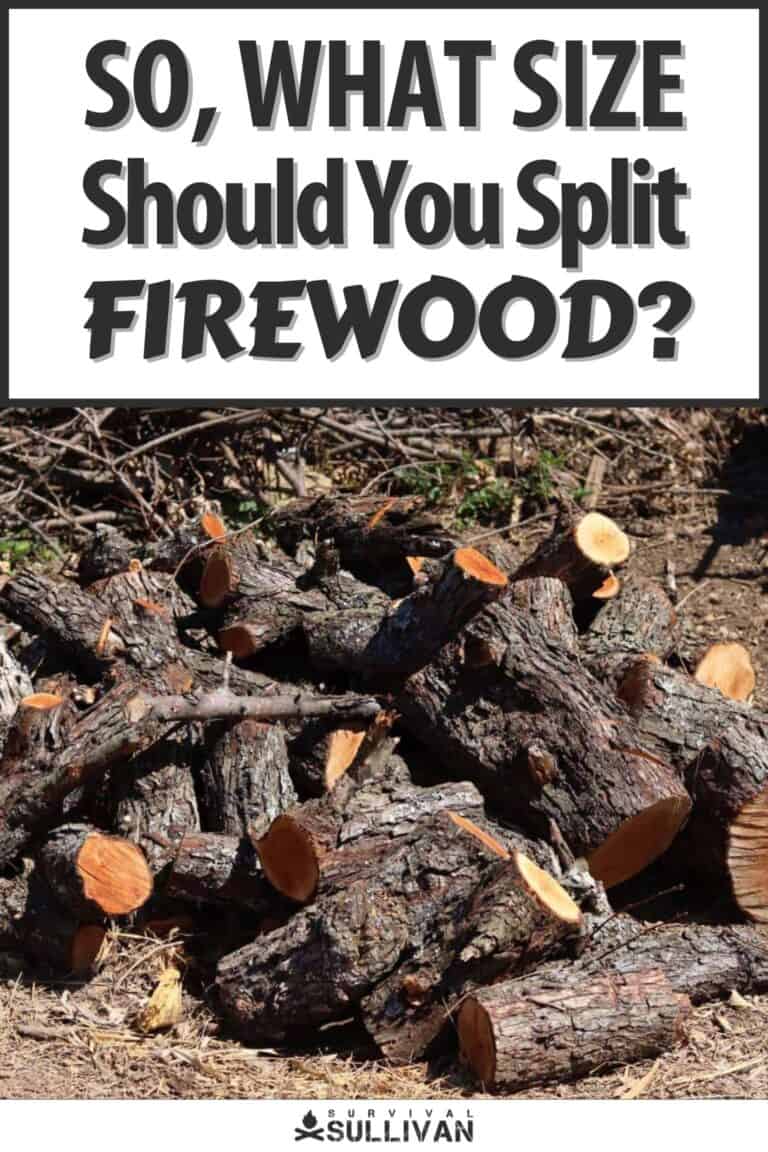If your home is heated by burning wood, whether it be through a wood stove or fireplace, then you already know the importance of having a healthy stockpile of split firewood nearby.

Veterans of the wood-splitting world will often chime in with different opinions on how big (or small) you should split your firewood for optimal burning.
Some might say there is no standard size for splitting firewood, while others will stick to a strict size.
Firewood should be split so that it is less than 6 inches in diameter and no longer than 16 inches. Keeping your firewood at this size provides a greater surface area for burning, and will fit most stoves.
Sure, splitting your firewood into the right size for your method of burning is important. However, there are other factors that play into this as well including how you split the wood and storage for the season.
What Is The Optimal Size To Split Firewood?
I explained the average length you should split your firewood is 6 inches wide, while the thickness should be 15 inches, but it really does depend on the stove or fireplace that you’re using as well as the condition of the original wood.
A wood stove and fireplace work best when you can add several pieces at once.
It creates air gaps that let the flames grow and get hotter. This means that having the capability to shove several larger pieces inside the stove is beneficial.
It might be a bit of a trial-and-error situation until you understand how your stove works.
If your wood comes wet then you want to split it into smaller pieces so that it dries out quickly and evenly; However, not too small that your woodstove will eat through a pile in a couple of hours.
What Tools Should You Use To Split Firewood?
There are many tools available designed to make the job a little easier splitting wood. You have options for both manual splitting and gasoline-powered technology.
Metal Wedges
Metal wedges are designed to go into the cracks of the log you’re splitting. Using a mallet you strike the wedge until it drives into the wood, splitting it.
This is an effective method that does take a lot of energy. Sometimes the logs are so thick that you will need multiple wedges in strategic spots to crack through them.
Wood Splitting Maul
A wood-splitting maul is both an axe and a wedge built into one. They usually have a long handle and the axe head itself is heavier than other axes.
The idea is to chop the axe into the wood and have the wedge shape split through the log.
Additionally, a splitting maul has a flat side on the head which can be struck with a mallet to drive it through the wood.
A splitting maul is a great tool to have on hand since it can be used to split wood or chop it into more manageable pieces.
Hydraulic Log Splitter
A hydraulic log splitter is a gasoline or diesel-fueled machine that pushes large logs down into an axe head, effectively splitting it.
These machines can push an incredible amount of power, pushing over a ton of pressure.
If you have large logs that need to be broken down then a log splitter is surely needed. A splitting maul or axe just cannot get through dense logs of that size.
Additionally, it is one of the least labor-intensive methods of splitting wood.
Since the machine is cracking all of the logs for you, your only job is to roll logs onto it and push them apart once they get split.
This is one of my favorite ways to split wood since there is nothing quite like the deep, resonant crack of a huge log being split.
Splitting Axe
Splitting axes are much like splitting mauls but the cutting point on the blade is much wider and thinner.
Mauls are meant to be hammered into the wood whereas a splitting axe is meant to bite deep down into the log and then eject it apart as it widens the crack.
Some splitting axes have a mechanism that uses the force of the swing to pry the wood apart as the splitting axe hits the wood.
Why Should You Split Your Firewood Ahead Of Time?
There are quite a few reasons to split your wood ahead of the season you’ll be using it in, in most cases that would be winter.
The most obvious reason is not to be left without fuel to heat your home, but here are a few more you may not have considered. Such as…
Seasoning Your Firewood
Burning wet or live wood will often result in a lot of smoldering and a lack of heat. It leads to an incomplete burn that causes creosote buildup in your stove pipe or chimney.
More creosote in your stove pipe means you have to clean it out more often or risk a chimney fire.
Seasoning your firewood is another way of saying that you’re drying it out. This process involves leaving it out in the sun and air until most, if not all of the moisture has evaporated.
This leaves you with bone-dry wood that will burn clean and give the maximum heat output.
Some of the key identifiers of seasoned firewood:
- Look for cracks – Seasoned firewood will often have cracks in the ends. As the wood dries it will start to shrink. Since the growth rings dry at different rates it’ll cause cracking as a result.
- It sounds different – Seasoned firewood will have a satisfying hollow sound when knocked together. It’s one of my favorite sounds in the dead of winter when I am processing firewood for a campfire.
- The color will change – If the firewood in your pile is a different color than normal wood, for example, if it’s gray, then it is another good sign that your wood is seasoned. Check out the center of the log as well, if it is a different color than the rest then the middle of your wood has yet to season.
If you have a good sense of smell, then you’ll be able to tell if it’s seasoned by the lack of a scent.
Once the moisture in the wood has all evaporated there is no carrier for a scent. If there is still moisture inside the firewood you will get a damp smell coming off of it.
Convenience Factors
Splitting your firewood in advance makes transport to your wood stove pretty quick. All it takes is a short trip to your wood shed to gather a bundle and bring it back into the main house.
Imagine you had to split wood before hauling it off to the stove. It would take extra time and energy, which will become an annoyance if you don’t split enough wood to last through the night.
Inclement weather makes for poor conditions to split wood which is another reason why you want to get ahead with your stack.
Feeling sick? The last thing you want to be doing is splitting wood for your fire while you are under the weather.
Burns Better As Split Wood
You need a pretty hot fire to burn through whole logs. This is because there is still some moisture usually left in the bark that the fire has to dry out before it gets to the dry wood inside.
Splitting your wood exposes the dry part inside which will catch a flame much faster. Since split wood is smaller than whole logs it also makes sense that it requires less heat to catch.
Portability
You’re not going to be bringing huge logs into your home to be put into a wood stove in a sustainable way. It simply requires too much energy and space.
Splitting your wood into manageable pieces has its benefits for both transportation and efficiency in burning. Smaller pieces give you more options for storage inside your home.
If you have a designated space inside where you store your firewood for quick access you can easily stockpile more. Fewer trips outside to the woodshed keep the heat inside your home.
Other Uses
If you’re a camping enthusiast who enjoys going out on an ATV, or snowmobile just sticking close to home, you can take your firewood camping.
This frees up time and effort that is usually spent on gathering and processing firewood at camp.
Community is important and when one person is having a hard time, their neighbors will step in and help.
You’d be surprised at how much wood one household can go through in a cold season, and sometimes you’re caught in short supply.
Being able to supply firewood to your neighbor in an emergency situation is another good reason to have a large supply built up.

Tips On Stacking Firewood
Once you’ve done all of the hard work of splitting your firewood it is important that you store it properly so that it does get wet or start to rot over the season.
Additionally, there is nothing as depressing as watching your wall of freshly stacked firewood topple over knowing you’re just going to have to build it up again.
Here are some tips on stacking your wood pile properly so that it doesn’t fall over and helps speed up the seasoning process.
Stacking Your Wood Correctly Matters
Keeping your wood stack off the ground is important to keep it dry. Seasoning your firewood requires that there be adequate airflow in between the pieces so that moisture can be wicked away as it emerges.
Alternating the position of the woof with each layer is important. Having an alternating layer of bark down and bark up will provide enough of an air gap so that a breeze can blow through the stack.
Try not to stack your wood more than 6 feet deep as then the center of the woodpile won’t be exposed to the air. The idea is to have the entire stack dry as evenly as possible.
Covering The Stack Against Inclement Weather
This may seem like a given but covering your woodpile against rain and snow is very important.
If any moisture gets at your firewood it will undo all of the drying that has already progressed. Leaving moisture unexposed to air will surely lead to rot and other issues.
If you have a covered wood shed then you are ahead of the game and probably won’t see any issues with moisture. Keep a close eye on any leaks and fix them as soon as you can.
For everyone else who has their wood piles outside in the open, using something like a tarp will ensure that your wood is not exposed to moisture.
Cover the top of your woodpile with the tarp, ensuring that you don’t completely cover the woodpile. You still need airflow to get in there for seasoning.
It doesn’t have to be an expensive tarp, just one from your local hardware store.
You can secure the tarp down on either side of the pile using bungee cords. This makes sure that the tarp stays secure during moments of heavy rain or wind.
Most people split their wood in the spring so that it dries throughout the summer and fall so there will be a lot of rain and storms.
Frequently Asked Questions
It is easier to split dry wood than it is wet wood. The water inside the wood creates resistance that absorbs the impact of the tool you’re using instead of redirecting it into the log. This absorption of energy makes it more difficult to split.
The easiest way to dry your firewood quickly is to split it into smaller pieces and lay it out in the sun separate from the other pieces.
Do not stack your wood if you need it to dry quickly since all of that wood in close proximity will keep the moisture inside longer.
It is wise not to stack your firewood pile up against your home for a couple of reasons:
1. Your wood could have termites or carpenter ants inside of it. These insects will naturally travel over into your home and wreak some serious structural havoc on the wood inside your walls.
2. Wood can only absorb so much water. If your stack gets rained on it can saturate enough that it starts to affect the materials behind which could ruin parts of your home.


Perrin is an adventure guide and naturalist currently living a nomadic life in the Canadian wilderness. His education and expertise is in wilderness survival and wildlife tracking. He enjoys teaching people about the outdoors and has managed large groups on expeditions.
With several accredited certifications, including being a wilderness first responder and a leave no trace expert, Perrin believes it is important for all of us to reconnect with the natural world.
